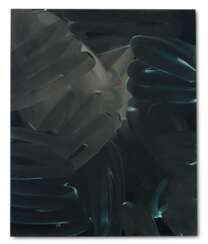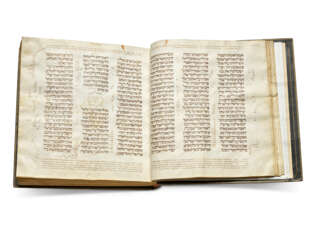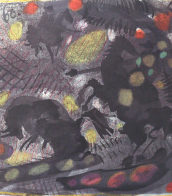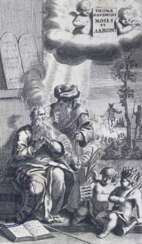ed moses

Edward Moses was an American abstract painter and graphic artist.
Ed Moses was an experimental, constantly changing and evolving artist. A characteristic feature of his abstract painting technique was that he rarely used a brush or paint, used colouring, knife and water splash techniques, worked with canvas, polyester and powder paint, and applied lines with tape.


Edward Moses was an American abstract painter and graphic artist.
Ed Moses was an experimental, constantly changing and evolving artist. A characteristic feature of his abstract painting technique was that he rarely used a brush or paint, used colouring, knife and water splash techniques, worked with canvas, polyester and powder paint, and applied lines with tape.


Edward Moses was an American abstract painter and graphic artist.
Ed Moses was an experimental, constantly changing and evolving artist. A characteristic feature of his abstract painting technique was that he rarely used a brush or paint, used colouring, knife and water splash techniques, worked with canvas, polyester and powder paint, and applied lines with tape.
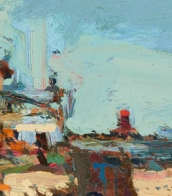

Edward Moses was an American abstract painter and graphic artist.
Ed Moses was an experimental, constantly changing and evolving artist. A characteristic feature of his abstract painting technique was that he rarely used a brush or paint, used colouring, knife and water splash techniques, worked with canvas, polyester and powder paint, and applied lines with tape.


Edward Moses was an American abstract painter and graphic artist.
Ed Moses was an experimental, constantly changing and evolving artist. A characteristic feature of his abstract painting technique was that he rarely used a brush or paint, used colouring, knife and water splash techniques, worked with canvas, polyester and powder paint, and applied lines with tape.


Edward Moses was an American abstract painter and graphic artist.
Ed Moses was an experimental, constantly changing and evolving artist. A characteristic feature of his abstract painting technique was that he rarely used a brush or paint, used colouring, knife and water splash techniques, worked with canvas, polyester and powder paint, and applied lines with tape.


Edward Moses was an American abstract painter and graphic artist.
Ed Moses was an experimental, constantly changing and evolving artist. A characteristic feature of his abstract painting technique was that he rarely used a brush or paint, used colouring, knife and water splash techniques, worked with canvas, polyester and powder paint, and applied lines with tape.


Edward Moses was an American abstract painter and graphic artist.
Ed Moses was an experimental, constantly changing and evolving artist. A characteristic feature of his abstract painting technique was that he rarely used a brush or paint, used colouring, knife and water splash techniques, worked with canvas, polyester and powder paint, and applied lines with tape.


Edward Moses was an American abstract painter and graphic artist.
Ed Moses was an experimental, constantly changing and evolving artist. A characteristic feature of his abstract painting technique was that he rarely used a brush or paint, used colouring, knife and water splash techniques, worked with canvas, polyester and powder paint, and applied lines with tape.


Edward Moses was an American abstract painter and graphic artist.
Ed Moses was an experimental, constantly changing and evolving artist. A characteristic feature of his abstract painting technique was that he rarely used a brush or paint, used colouring, knife and water splash techniques, worked with canvas, polyester and powder paint, and applied lines with tape.


Edward Moses was an American abstract painter and graphic artist.
Ed Moses was an experimental, constantly changing and evolving artist. A characteristic feature of his abstract painting technique was that he rarely used a brush or paint, used colouring, knife and water splash techniques, worked with canvas, polyester and powder paint, and applied lines with tape.


Edward Ruscha, an American artist born in 1937, is a prominent figure associated with West Coast Pop art, celebrated for his innovative approach to blending visual and verbal language within his works. Ruscha's journey in the art world began after moving to Los Angeles in 1956, where his fascination with the urban landscape and commercial culture flourished. He attended Chouinard Art Institute, now known as CalArts, which laid the foundation for his artistic exploration.
Edward Ruscha's art is deeply influenced by the Hollywood film industry, with works like "Large Trademark with Eight Spotlights" echoing the commercial graphics and cinematic influence of his time. His "Word paintings" series, starting in the 1960s, showcases his unique approach to typography and language, setting monosyllabic words against solid backgrounds, a style that continued to evolve throughout his career.
During the 1970s, Edward Ruscha expanded his narrative, incorporating phrases into his works, further exploring the relationship between text and image. His work in the 1980s and beyond includes landscapes juxtaposed with text, creating intriguing visual narratives that challenge viewers to find connections between the words and the images.
Edward Ruscha's contributions to the art world are significant, with his works held in major collections and institutions. His career spans various mediums, including painting, printmaking, photography, and artist's books, showcasing his versatility and enduring influence on contemporary art.
For enthusiasts and collectors of modern art, Edward Ruscha's works offer a unique blend of visual artistry and linguistic play. His innovative approach to combining text and image has cemented his status as a pivotal figure in contemporary art. To stay updated on the latest exhibitions, sales, and insights related to Edward Ruscha's art, consider subscribing to updates from renowned art galleries and auction houses. This subscription will ensure you're informed about new opportunities to engage with and appreciate the distinct and influential art of Edward Ruscha.


Marc Chagall (Russian: Марк Заха́рович Шага́л), born Moishe Shagal in 1887 near Vitebsk, Belarus (then part of the Russian Empire), was a Belarusian and French artist celebrated for his pivotal role in the avant-garde movement and his unique integration of Eastern European Jewish culture into modern art. His contributions spanned several artistic formats including painting, stained glass, stage sets, ceramics, tapestries, and fine art prints. Chagall's early modernist tendencies were enriched by his experiences across Saint Petersburg, Paris, and Berlin before World War I, leading to a distinctive style that melded Cubism, Symbolism, and Fauvism with his Jewish heritage.
Chagall's work is recognized for its emotional depth, often exploring themes of love, memory, and Jewish folklore through vibrant colors and dreamlike imagery. Notably, art critic Robert Hughes described him as "the quintessential Jewish artist of the twentieth century," a sentiment echoed by art historian Michael J. Lewis who regarded Chagall as a significant figure within European modernism and as the world's preeminent Jewish artist of his time.
Among Chagall's famed contributions are his stained-glass windows for the cathedrals of Reims and Metz, the UN, and the Jerusalem Windows in Israel. His monumental paintings include parts of the ceiling of the Paris Opéra and works that explore biblical themes, a hallmark of his oeuvre that underscores his enduring engagement with spiritual and religious motifs.
For art collectors and antiques experts, Chagall's works are notable not only for their artistic innovation but also for their rich cultural and historical significance. His art is housed in many prestigious museums worldwide, including the Marc Chagall National Museum in Nice, France, which focuses on his works inspired by religion and houses the series of paintings illustrating the biblical message.
For those interested in exploring Chagall's legacy and the vibrant intersection of culture, art, and history his work represents, signing up for updates on new product sales and auction events related to Marc Chagall can provide invaluable insights and opportunities. This is an invitation to engage more deeply with the world of art and culture that Chagall so uniquely encapsulated in his work.

_4.jpg)
John Goddard (1724–1785) was a distinguished American cabinetmaker whose work significantly influenced 18th-century furniture design, particularly in Newport, Rhode Island. Born on January 20, 1724, in Dartmouth, Massachusetts, Goddard apprenticed under Job Townsend, a prominent Newport cabinetmaker. This apprenticeship not only honed his craftsmanship but also led to his marriage to Townsend's daughter, Hannah, further solidifying his ties to the esteemed Townsend-Goddard furniture-making dynasty.
Establishing his own workshop in Newport, Goddard became renowned for his exceptional skill and innovative designs. He is credited with originating the block-front knee-hole desks and secretary desks, which became highly sought after by affluent clients. His creations are characterized by distinctive features such as the block-front facade, intricately carved shells, and robust ball-and-claw feet. These elements not only exemplify the aesthetic preferences of the period but also showcase Goddard's meticulous attention to detail and mastery of proportion.
One of Goddard's most notable patrons was Nicholas Brown, a prominent Providence merchant. In the early 1760s, Brown commissioned a set of elaborately carved mahogany side chairs from Goddard. These chairs, distinguished by their pierced crest shells, double-scrolled splats, and elegantly shaped stretchers, are considered masterpieces of Newport craftsmanship. The collaboration between Goddard and Brown underscores the cabinetmaker's reputation as "the neatest workman in America," a testament to his superior craftsmanship and design sensibilities.
Goddard's influence extended beyond his lifetime, as his workshop became a training ground for future artisans, including his sons. Following the British occupation of Newport, three of his sons relocated to Nova Scotia, where they continued the family's cabinetmaking tradition, thereby disseminating the Newport style to new regions. The Goddard family's contributions to furniture making have left an indelible mark on American decorative arts, with their pieces remaining highly prized by collectors and museums alike.
Today, John Goddard's works are preserved in esteemed institutions such as The Metropolitan Museum of Art, which houses a side chair attributed to him. This chair exemplifies the characteristic Newport knee carving and the spherical ball feet associated with Goddard's style, serving as a tangible representation of his enduring legacy in American furniture design.



